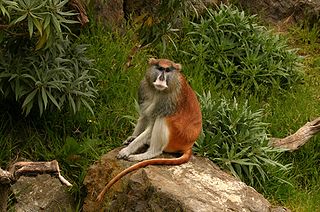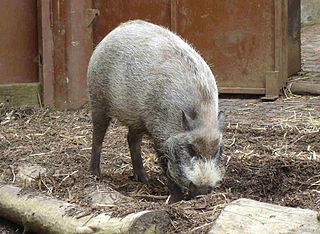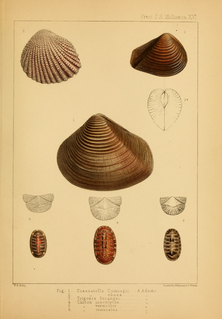
The common warthog is a wild member of the pig family (Suidae) found in grassland, savanna, and woodland in sub-Saharan Africa. In the past, it was commonly treated as a subspecies of P. aethiopicus, but today that scientific name is restricted to the desert warthog of northern Kenya, Somalia, and eastern Ethiopia.

Erythrocebus is a genus of Old World monkey. All three species in this genus are found in Africa, and are known as patas monkeys. While previously considered a monotypic genus containing just E. patas, a 2017 review argued that, based on morphological evidence and heavy geographic separation between taxa, E. patas should be split back into distinct species as recognised in the 19th century.

The Integrated Taxonomic Information System (ITIS) is an American partnership of federal agencies designed to provide consistent and reliable information on the taxonomy of biological species. ITIS was originally formed in 1996 as an interagency group within the US federal government, involving several US federal agencies, and has now become an international body, with Canadian and Mexican government agencies participating. The database draws from a large community of taxonomic experts. Primary content staff are housed at the Smithsonian National Museum of Natural History and IT services are provided by a US Geological Survey facility in Denver. The primary focus of ITIS is North American species, but many biological groups exist worldwide and ITIS collaborates with other agencies to increase its global coverage.

Neogastropoda is a order of sea snails, both freshwater and marine gastropod molluscs.
International Dance Day is a global celebration of dance, created by the Dance Committee of the International Theatre Institute (ITI), the main partner for the performing arts of UNESCO. The event takes place every year on 29 April, which is the anniversary of the birth of Jean-Georges Noverre (1727–1810), the creator of modern ballet. The day strives to encourage participation and education in dance through events and festivals held on the date all over the world. UNESCO formally recognize ITI to be the creators and organizers of the event.

Genovese basil is a cultivar of Ocimum basilicum. It is one of the most popular basils for culinary use, particularly for its use in pesto, the traditional Genoese sauce. The name "Basilico Genovese" is protected by the European Union with the Denominazione di Origine Protetta certification. Genoese basil is produced in the provinces of Genoa, Savona and Imperia.

Homopus is a genus of tiny tortoises in the family Testudinidae, endemic to southern Africa. Three species have been moved to the genus Chersobius.
The Niangara free-tailed bat or Niangara mops bat is a species of bat in the family Molossidae known only from its holotype. It is endemic to Democratic Republic of the Congo. Its natural habitat is either moist tropical forest or savanna.

The desert warthog is a species of even-toed ungulate in the pig family (Suidae), found in northern Kenya and Somalia, and possibly Djibouti, Eritrea, and Ethiopia. This is the range of the extant subspecies, commonly known as the Somali warthog. Another subspecies, commonly known as the Cape warthog, became extinct around 1865, but formerly occurred in South Africa.

Phacochoerus is a genus in the family Suidae, commonly known as warthogs. They are pigs who live in open and semi-open habitats, even in quite arid regions, in sub-Saharan Africa. The two species were formerly considered conspecific under the scientific name Phacochoerus aethiopicus, but today this is limited to the desert warthog, while the best-known and most widespread species, the common warthog, is Phacochoerus africanus.

Suinae is a subfamily of artiodactyl mammals that includes several of the extant members of Suidae and their closest relatives – the domestic pig and related species, such as babirusas. Several extinct species within the Suidae are classified in subfamilies other than Suinae. However, the classification of the extinct members of the Suoidea – the larger group that includes the Suidae, the peccary family (Tayassuidae), and related extinct species – is controversial, and different classifications vary in the number of subfamilies within Suidae and their contents. Some classifications, such as the one proposed by paleontologist Jan van der Made in 2010, even exclude from Suinae some extant taxa of Suidae, placing these excluded taxa in other subfamilies.

River Gambia National Park is a national park in the Gambia.

ITI Limited, earlier known as Indian Telephone Industries Limited, is a government-owned telecommunications equipment manufacturer in India. It is under the ownership of Department of Telecommunications, Ministry of Communications, Government of India. It was founded in 1948 as a departmental factory, incorporated as a public company in 1950 and today has six manufacturing facilities at Bengaluru, Naini, Mankapur, Raebareli, Palakkad and Srinagar which produce a range of switching, transmission, access and subscriber premises equipment. It is headquartered at Bengaluru. It has multi-locational electronic assembly and mechanical manufacturing facilities, countrywide marketing and customer support centers and in-house R&D for absorption of technology, indigenous development of products for in-house manufacturing.

Hipposideros rotalis, the Laotian leaf-nosed bat or Laotian roundleaf bat, is a species of bat from the family Rhinolophidae which is thought to be endemic to Laos. Only a small number of individuals have been recorded, however the population size is thought to be large as it has been found to cover a range of more than 20,000 km2.
The eastern barbastelle or Asian barbastelle is a species of vesper bat found throughout much of Asia, from Afghanistan to Taiwan.
Heterocyemida is an order of parasites which dwell in the renal appendages of cephalopods.

Carditoidea is a superfamily of marine bivalve clams.

Crassatelloidea is a superfamily of bivalves in the order Carditida. In the World Register of Marine Species (WoRMS), Astartoidea is considered a junior synonym of Crassatelloidea, whereas in ITIS Astartoidea is a separate family containing Astartidae and Cardiniidae – Cardiniidae itself being classified instead in Carditoidea by WoRMS.

The Socotran pipistrelle or Lanza's pipistrelle is an endangered species of vesper bat in the family Vespertilionidae. It is endemic to Socotra Island in Yemen, and is the only mammal thought to be endemic to the island.














